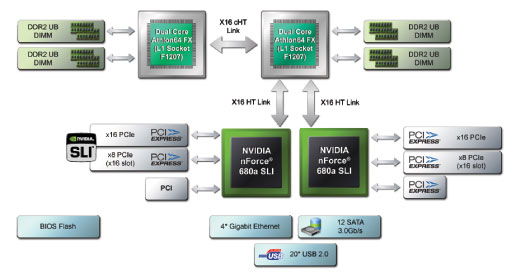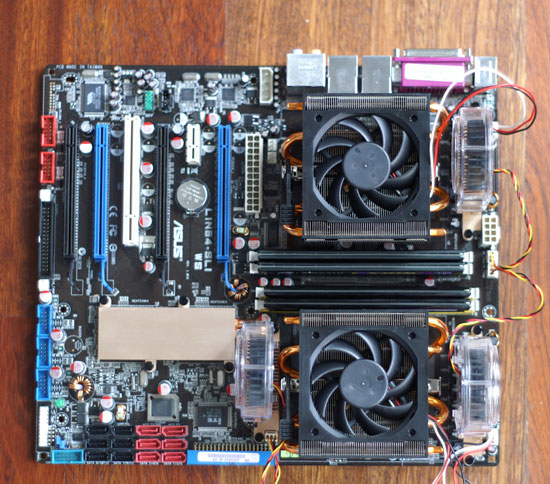AMD's Quad FX: Technically Quad Core
by Anand Lal Shimpi on November 30, 2006 1:16 PM EST- Posted in
- CPUs
The Platform
With the recent ATI acquisition under its belt, AMD has started down the path of becoming a platform company. As such it's almost fitting that the most interesting part of today's story isn't the CPUs, but rather the chipset and motherboard that complete Quad FX.
When AMD first talked about Quad FX as 4x4, everyone assumed that we would be looking at a pair of Socket-AM2 CPUs on a desktop motherboard. However as we got closer to launch it quickly became evident that Quad FX would be using Opteron's new Socket-1207 instead. The reason for using Socket-1207 instead of AM2 is simple; in a single socket AM2 system you only need a single Hyper Transport link between the CPU and the chipset, which is provided for in AM2 CPUs. However, with two sockets you need a minimum of two links, one connecting the two sockets and one for the chipset. It's the number of HT links required that forced the 1207-pin socket upon Quad FX. We will get to how this impacts your upgrade path and CPU costs later, but for now just know that Quad FX only works with 1207-pin Athlon 64 FX CPUs (Opterons are prevented from working in the BIOS).
Despite the ATI acquisition, the only Quad FX chipset available at launch is from NVIDIA. Dubbed the nForce 680a, NVIDIA once again gives us a reason to respect its platform group. Although singular in name, the nForce 680a is composed of two 680a SLI chips, each with a x16 and x8 PCIe slot. One of the two chips has an additional 8 PCIe lanes bringing the total up to 56 lanes, more than any other NVIDIA chipset, including the recently released 680i.

The madness doesn't end with the sheer number of PCIe lanes; the 680a also supports a total of four GigE ports, twelve SATA ports and twenty USB 2.0 ports. All of the usual nForce features are present on the 680a, including SLI support, RAID and NVIDIA's networking (FirstPacket and Teaming support). The chipset is a pure beast and we were eager to see an implementation of all of the PCIe, GigE, SATA and USB ports that the 680a supports on the first Quad FX motherboards; unfortunately we were met with disappointment.

AMD's Quad FX platform is launching with a single motherboard partner, ASUS, and a single Quad FX motherboard: the L1N64-SLI WS. The ASUS board features four physical x16 slots (two x16 and two x8), a single x1 PCIe slot and one regular PCI slot.

You also get all twelve SATA ports, but there's only support for ten USB ports and two GigE ports. Obviously the number of people that will complain about not having all twenty USB ports and four GigE ports are limited, but with AMD expecting the L1N64-SLI WS to retail for around $370, we wanted all of the bells and whistles.

We asked AMD when we could expect other Quad FX motherboard designs but at this point it looks like the ASUS solution is it. AMD is working with more motherboard partners but there's no indication if or when additional Quad FX designs will surface.

AMD is guaranteeing a bit of an upgrade path to early adopters of Quad FX by promising that these motherboards will work with AMD's native quad-core CPUs when they are available next year, meaning you'll get support for eight cores in the same platform in less than a year.










88 Comments
View All Comments
Viditor - Thursday, November 30, 2006 - link
If they can...
The 680a chipset has a direct HT link to each MCP, the 680i obviously can't do that and must bridge through the SPP.
Now if only we could find a review that actually showed that...;)
Seriously, the one major benefit of Quad FX is that it can run 4 GPUs. While I appreciate all of the conjecture and speculation, it isn't really a test of the facts, is it?
defter - Friday, December 1, 2006 - link
<quote>Seriously, the one major benefit of Quad FX is that it can run 4 GPUs.</quote>How that's a benefit? You can have 8 GPUs in a same system (AMD or Intel based, it doesn't matter) with a couple of NVIDIA Quadro Plex 1000 Model II's if money isn't an issue:
http://www.nvidia.com/page/quadroplex_comparison_c...">http://www.nvidia.com/page/quadroplex_comparison_c...
JarredWalton - Friday, December 1, 2006 - link
Fact: Quad SLI (7950 GX2) works on 590 SLI and 680i.Fact: Quad SLI (8800 GTX) does not exist.
Until the second item changes, we only have the first to go on, which is that current quad SLI works - at least as much as it works anywhere - on both platforms. And the QSLI drivers are still largely broken - you can run benchmarks, but as soon as you start playing lots of games rather than just benching, problems crop up. Neverwinter Nights 2 for example doesn't even run properly with CrossFire or SLI, so let's not even worry about getting QSLI support for now.
JackPack - Thursday, November 30, 2006 - link
8800 GTX requies two slots, which means it won't fit in the 4x4 motherboard. Quad-SLI performance has already shown to be poor using two 7950 GX2 cards. Finally, how do you bridge four 8800 cards together?Viditor - Thursday, November 30, 2006 - link
Huh?
http://www.bit-tech.net/hardware/2006/11/08/nvidia...">Single slot 8800 GTX
This is only when using a single MCP, the 680a uses dual MCPs.
The 680i uses one MCP and one SPP.
By having 2 sets of bridges (one bridge per MCP).
JarredWalton - Friday, December 1, 2006 - link
Quad SLI has problems whether or not you have dual MCPs. It's driver and software related - basically the drivers don't do AFR on a lot of titles and so you end up with lower than 7900 GTX SLI performance.As for two slots, they're talking the width of the cards. They only plug into one slot, but they fill the adjacent slot. Quad 8800 GTX would require eight expansion slots right now. Given that Vista 8800 drivers aren't even out yet, I think NVIDIA has other things to do before they worry about moving beyond SLI'ed 8800 cards.
PrinceGaz - Thursday, November 30, 2006 - link
I suppose you could replace the HSF with something smaller which would fit in a single-slot, which would have to mean water-cooling.Quad-SLI performance (or lack of) is probably a driver-issue.
Don't 8800 cards have two SLI sockets therefore allowing you to chain together as many as you like (in theory)?
casket - Thursday, November 30, 2006 - link
It appears with win-xp sp2... this quad fx stinks. How about Win 2003 or Vista Ultimate? It might change things drastically.Neosis - Thursday, November 30, 2006 - link
I don't think the problems in the benchmarks are not an opperating system issue. Two processors having totally four cores are not the same as a processor having the same number of cores. Additional latencies will slow down the performance.Viditor - Thursday, November 30, 2006 - link
Actually, they probably are...Windows XP is not NUMA aware, while Vista is.
In this case there is no difference...the Kentsfield has exactly the same latency as a 2 socket dual core because the 2 dual cores on-board don't talk directly with each other.